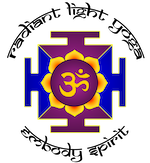Articles
Pratyahara and Yoga Therapy
By Akash
Pratyahara comprises the 5th limb of the eight-fold path of Patanjali. It is the essential ability to withdraw the lifeforce from the entanglements and allures of the senses, in order to redirect it inwards. When a devotee has attained pratyahara, he or she possesses the power to switch off the current of lifeforce from the hearing, seeing, smelling, tasting, and touch nerve centers. Thus the sensory perceptions are offered into the flame of self-control; the controlled inner awareness of dynamic peace.
Once the prana begins to flow inwards and upwards, true yoga practise begins. The chakras are enlivened by this selfsame redirected prana, and the vitality and inner awareness necessary for awakening is enkindled.
For the Yogi on his or her conscious journey towards enlightenment, Pratyahara is the natural result of Pranayama practise. Having learned to control and expand the prana, we are naturally guided by the Atman to reclaim all dispersed energies for the primary goal of yoga: the awakening of the kundalini serpent power at the base of the spine.
Pratyahara and the healing journey
The ability to choose when and where to direct prana, and to choose to channel it internally, is at the heart of healing. To master pratyahara and pranayama is to master the highest technique of healing.
Let us explore pratyahara as a component of a yoga therapy regime.
To practise pratyahara is to practise the divine power of free choice. We have free choice as to the quality of all our sensory input: the foods we eat, the music we listen to, the movies we watch, the subtle impressions that nourish or disturb the mind.
To create the optimal environment for our students’ healing, we must address the practise of self-discipline in the form of sensory intake. This is a form of pratyahara necessary for balance and wholeness.
In guiding our students toward a revitalizing understanding of pratyahara, we must begin by withdrawing the senses from anything that will harm their wellbeing. The first phase of pratyahara, then, is distinguishing which components in a student’s life are causing the imbalances.
First there must be a willingness to step back and observe what foods, associations, and sensory stimulation are not serving your student’s highest good and health. This is an exploration that is crucial to her path of healing. You may want to employ the following list:
- Workplace environment
- Music
- Reading
- Television
- Friends and acquaintances
- Diet
- Home environment
Explore together what aspects from each category are strengthening, and which are weakening. Allow your student to be creative in finding ways to minimize any weakening influences and to emphasize strengthening ones. Awareness always brings light. Simply seeing how various sensory impressions are impacting health can be a real eye-opener that leads to powerful lifestyle changes.
In ayurveda there is a concept known as “Pragya Aparadha”. This translates as “Crimes against Wisdom. Wherever there is an imbalance, there must be a “Pragya Aparadha”. Help your student to discover what that may be.
Conservation of energy and yoga therapy
One of the most effective ways to practise pratyahara and to regain wholeness is by simplification. By discovering ways to simplify our lives we may reclaim vast amounts of healing prana that is being dispersed unnecessarily. Many people need someone to sit down and walk through this process in order to find a new way of living. The yoga therapist can be that helping person. In the process of simplification we become like little children, able to fully enjoy all the little and beautiful things that get lost when we are too busy, or have too many possessions.
When our diet becomes more pure, we enjoy our food more. When we choose a walk in nature over a stimulating movie, our soul sings, our lungs are cleansed, and our minds become still. Turning off the phone or television for certain pre-arranged times gives us space to enjoy the beauty of quiet. And of course, the practise of meditation is supreme for conserving the vital force of healing.
Take the time to explore this important theme with your student. Encourage her/him to keep a journal to record the shifts she/he may experience in the process of pratyahara. You may both be amazed to see just how important it is.
